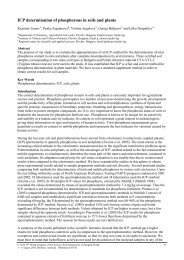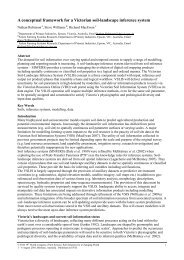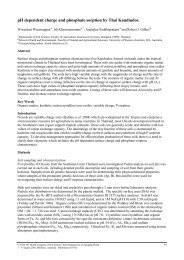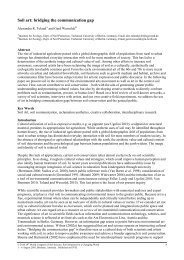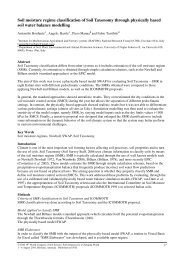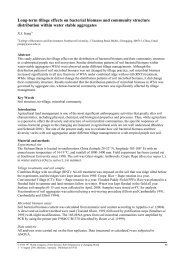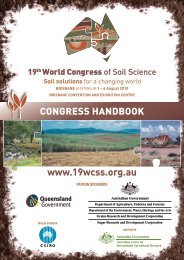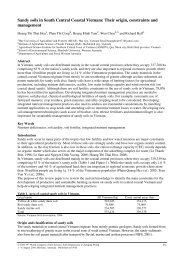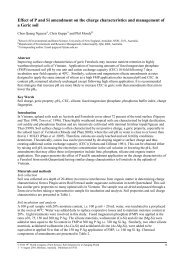Islam AKM Saiful - International Union of Soil Sciences
Islam AKM Saiful - International Union of Soil Sciences
Islam AKM Saiful - International Union of Soil Sciences
You also want an ePaper? Increase the reach of your titles
YUMPU automatically turns print PDFs into web optimized ePapers that Google loves.
Water and fuel saving technologies: Unpuddled bed and strip tillage for wet<br />
season rice cultivation in Bangladesh<br />
<strong>AKM</strong> <strong>Saiful</strong> <strong>Islam</strong> A , ME Haque B , MM Hossain C , MA Saleque D and RW Bell E<br />
A Dept. <strong>of</strong> FPM, Bangladesh Agricultural University, Mymensingh, Bangladesh, Email akmsaifulislam68@gmail.com<br />
B <strong>International</strong> Maize and Wheat Improvement Centre (CIMMYT), Bangladesh, Email e.haque@cgiar.org<br />
C Dept. <strong>of</strong> FPM, Bangladesh Agricultural University, Mymensingh, Bangladesh, Email mosharraf53@yahoo.com<br />
D <strong>Soil</strong> Science Division, Bangladesh Rice Research Institute, Gazipur, Bangladesh, Email asaleque_brri@yahoo.com<br />
E Murdoch University, WA, Australia, Email R.bell@murdoch.edu.au<br />
Abstract<br />
Shortages <strong>of</strong> water and the rapid spread <strong>of</strong> two-wheel tractors (2WT) have created the opportunity to develop<br />
locally-adapted conservation agriculture (CA) techniques for crop establishment by rice-based smallholders<br />
in South Asia. During 2009, the wet season rice (Oryza sativa L.) was transplanted into minimum tillage<br />
puddled; unpuddled-bed and strip tillage conditions in the drought-prone area <strong>of</strong> Bangladesh, to assess<br />
establishment methods that could reduce crop production cost and water use. Land preparations were done<br />
by the 2-WT operated, Versatile Multi-crop Planter (VMP) recently developed by CIMMYT, Bangladesh.<br />
Tillage treatments did not influence the shoot dry matter production. There was 65 % less diesel fuel<br />
required in the strip tillage treatment than with beds formed by VMP. Labour requirement for land<br />
preparation in beds formed by a shaper were 4.5 times higher than single pass puddling and beds formed by<br />
VMP. Time required to transplant seedlings was almost doubled in unpuddled plots relative to puddled plots.<br />
Weeding cost was higher in beds formed by VMP and strip tillage plots compared to other tillage treatments.<br />
Regardless <strong>of</strong> tillage treatment, 41-43 % less irrigation water was used by crops established by VMP planting<br />
operations as compared to a traditional tillage system.<br />
Key Words<br />
Versatile Multi-crop Planter, drought, bed formation, transplanted rice<br />
Introduction<br />
The northwest region <strong>of</strong> Bangladesh has drought prone areas, even though mean annual rainfall is 1645 mm<br />
(BMDA 1995). This area is covered with thick clay layers, which have low permeability. At the same time,<br />
the average depths <strong>of</strong> the deep tubewells already sunk into the soil are greater in comparison with other areas<br />
<strong>of</strong> Bangladesh (Khan et al. 1997). Due to uneven distribution <strong>of</strong> rainfall and limited availability <strong>of</strong> surface<br />
water, groundwater becomes the main source <strong>of</strong> irrigation water. Climate change, particularly higher<br />
temperatures, and higher rates <strong>of</strong> groundwater withdrawal may exacerbate drought during cool and dry<br />
seasons. Lower rainfall reduces recharge to the aquifers. The water table is declining and many <strong>of</strong> the<br />
tubewells are inoperable in the dry season (Bhuiyan 1982). Moreover, at the end <strong>of</strong> the transplanted rice<br />
season, puddled paddy fields dry and form cracks. The cracks accelerate water evaporation. The hard, dry<br />
surface <strong>of</strong> such soils hindered crop establishment until the introduction <strong>of</strong> 2-WT for cultivation. Presently,<br />
more than 0.35 million Chinese-made 2-WTs are being used in Bangladesh for agricultural purposes (Haque<br />
et al. 2004). Conservation agriculture helps farmers to reduce production costs while maintaining or<br />
increasing crop yields, and improving soil health, crop diversity and timeliness <strong>of</strong> cultivation. The CA<br />
technologies like reduced tillage, strip tillage, bed planting, and direct seeding might be applicable to<br />
conditions in northwest Bangladesh. Successful development <strong>of</strong> 2-WT based implements, zero tillage, strip<br />
tillage, minimum tillage and bed planters in Bangladesh have created several avenues for the pursuit <strong>of</strong> CA.<br />
However, farmers could only afford to engage in CA if they could purchase a single implement able to<br />
perform many operations. Thus, the 2-WT tractor operated VMP was developed with the provision to use<br />
adjustable row spacing <strong>of</strong> crops for zero tillage, strip tillage, minimum tillage, bed planting, and even<br />
conventional tillage operation; seeding and fertilizer application occur simultaneously in a single pass<br />
operation (UNAPCAEM 2009). A single tillage system is not feasible for all soils and climatic conditions.<br />
Therefore, the choice <strong>of</strong> the best suited tillage system must be appropriate for the particular agroecological<br />
environment. In this study, different tillage systems were compared in wet season rice during 2009 for<br />
establishing rice in a drought-prone zone <strong>of</strong> Bangladesh.<br />
Methodology<br />
The experiment was conducted at the Bangladesh Rice Research Institute (BRRI), Regional station,<br />
Rajshahi. The study area lies at 24°69´N and 88°30´E. Agroclimatic (rainfall, evapotranspiration and thermal<br />
© 2010 19 th World Congress <strong>of</strong> <strong>Soil</strong> Science, <strong>Soil</strong> Solutions for a Changing World<br />
1 – 6 August 2010, Brisbane, Australia. Published on DVD.<br />
169
condition) data were collected from the BRRI weather station. Initial bulk density in 0-7.5 cm depth was<br />
1.21 (g/cm 3 ) at 39.7 % gravimetric water content and bulk density in 7.5-15 cm depth was 1.51 (g/cm 3 ) at<br />
26.3 % gravimetric water content. The soil pH and organic carbon in the experimental field were 7.96 and<br />
7.9 g/kg, respectively.<br />
Four tillage treatments in the experiment were: (i) Single pass puddling by 2 WT (T 1 ); (ii) Single pass<br />
puddling by 2 WT followed by bed formed by operating a shaper tool manually 8 days after transplanting<br />
(T 2 ); (iii) Bed formed by VMP in single pass (T 3 ) and; (iv) Strip tillage by VMP in single pass (T 4 ). The plot<br />
size was 221 m 2 . Before transplanting, land was leveled in the puddled plots. Two persons were engaged in<br />
the leveling operation. One labourer was needed to pull the shaper in the puddled field. The shaper was<br />
operated in the field three times to form a good bed shape. Wet season rice (July – November) grown was<br />
BR11, a popular high yielding variety. Thirty-five day old seedlings were transplanted in all tillage<br />
treatments. Seedlings were transplanted into puddled conditions (T 1 and T 2 ) or unpuddled conditions (T 3 and<br />
T 4 ). The treatments were arranged in a randomized complete block (RCB) design. The seedling spacing for<br />
T 1 and T 2 was 25 x 15 cm, and 20 x 15 cm for T 3 and T 4 . In the T 2 and T 4 treatments, the width <strong>of</strong> beds and<br />
furrows were 35 cm and 20 cm, respectively. Data on task time, fuel consumption and agronomic<br />
performance were collected from all treatment plots. Derived-carbon dioxide emissions from field operations<br />
were calculated from the diesel used in tillage operation using the conversion factor <strong>of</strong> 2.6 kg <strong>of</strong> CO 2 per kg<br />
<strong>of</strong> diesel consumed (Greece 2003). Duncan’s Multiple Range Test (DMRT) was used to determine the<br />
significant differences among the treatments.<br />
Results and discussion<br />
Fuel consumption<br />
Fuel consumption was significantly higher (26.8 l/ha) in T 3 treatment than other treatments (Table 1). Fuel<br />
consumption in T 4 treatment was lowest (9.5 l/ha) among the tillage treatments i.e. 65 % less fuel was<br />
required compared to T 4 . Conventional puddling required 16.5 l/ha whereas, tilling and seeding operation<br />
done by 2 WT operated seeder (PTOS) in single pass operation saved 40 % <strong>of</strong> diesel fuel per hectare per year<br />
(Miah et al. 2008). Carbon dioxide emission was higher (69.7 kg/ha) in T 3 treatment whereas CO 2 emission<br />
was lower in T 4 treatment (24.7 kg/ha) (Figure 1). Conventional puddling was done by 2 WT and required 4-<br />
5 passes to make a favourable condition for establishing transplanted rice. Strip tillage method reduced by 65<br />
and 48 % CO 2 emission as compared to the bed by VMP and single pass puddling operations, respectively.<br />
CO 2 emission, kg/ha<br />
80<br />
70<br />
60<br />
50<br />
40<br />
30<br />
20<br />
10<br />
0<br />
T1 T2 T3 T4<br />
Tillage practices<br />
Figure 1. Effect <strong>of</strong> tillage practices on carbon dioxide emission.<br />
Field capacity<br />
Tillage treatments had a significant effect on the field capacity (Table 1). Field capacity <strong>of</strong> VMP during bed<br />
formation in a single pass was lowest i.e. (0.065 ha/hr). Conventionally, a farmer would use 6-8 tillage<br />
passes, 2-3 leveling passes and 50-60 man days labour (0.002 hr/ha) to make a bed. Whereas, the field<br />
capacity <strong>of</strong> 2 WT using the rotavator to puddle the plot in a single pass operation was 0.166 ha/hr.<br />
Labour requirement in land preparation and transplanting<br />
Land preparation included tillage operation by VMP and puddling, leveling and shaper operation manually.<br />
Labour requirement for land preparation in T 2 treatment was 4.5 times higher than in T 1 and T 4 (Table 1).<br />
There was no significant difference in labour requirements for land preparation between T 1 and T 4 . The<br />
greatest time was required for transplanting seedlings in T 4 (296.1 man-hr/ha) i.e. almost double the time<br />
needed in T 1 and T 2 (Table 1). Poor visibility <strong>of</strong> strips under muddy flood water caused difficulties for<br />
people when transplanting seedlings in the hard surface <strong>of</strong> untilled soils. Similar problems were encountered<br />
when transplanting seedlings in T 3 . The whole plot was inundated one day before transplanting so the soil<br />
© 2010 19 th World Congress <strong>of</strong> <strong>Soil</strong> Science, <strong>Soil</strong> Solutions for a Changing World<br />
1 – 6 August 2010, Brisbane, Australia. Published on DVD.<br />
170
was not s<strong>of</strong>t enough to push the seedling roots into the soil easily.<br />
Table 1. Tillage effect on fuel consumption, field capacity, labour requirement in land preparation and<br />
transplanting.<br />
Treatment Fuel consumption Field capacity<br />
Labour requirement (man-hr/ha)<br />
(l/ha)<br />
(ha/hr) Land preparation Transplanting<br />
T 1 19.5 ab 0.166 a 19.2 c 151.1 c<br />
T 2 18.6 b 0.160 ab 85.5 a 168.2 bc<br />
T 3 26.8 a 0.065 c 32.3 b 200.6 b<br />
T 4 9.5 c 0.109 bc 19.0 c 296.1 a<br />
In a column, means followed by a common letter are not significantly different at 5 % level by DMRT.<br />
Irrigation water savings<br />
CA tillage treatment types did not have any significant effect on irrigation water requirement during wet<br />
season rice cultivation, but about 41-43% less water was required compared to reports from a conventional<br />
tillage system by Rashid (2005) (Table 2). Lowest water usage was required in T 3 (614 mm). Rahman and<br />
<strong>Islam</strong> (2008) observed that 37 % water usage can be saved if rice is transplanted in a bed as compared to the<br />
conventional tillage system without sacrificing grain yield during the dry season (January to May).<br />
Table 2. Water requirement in different tillage system.<br />
Treatment No. <strong>of</strong> irrigation Irrigation<br />
water, mm<br />
Effective<br />
rainfall 1 , mm<br />
Total water,<br />
mm<br />
Conventional tillage* Not available 207 775 1082 * -<br />
T 1 10 260 376 636 41<br />
T 2 10 254 376 630 42<br />
T 3 10 240 376 614 43<br />
T 4 10 247 376 623 42<br />
*Rashid (2005), 1 http://www.alanasmith.com/theory-Calculating-Effective-Rainfall.htm<br />
Water savings<br />
(%)<br />
Effect <strong>of</strong> tillage on plant height, number <strong>of</strong> tillesr per hill, and crop growth rate<br />
Numbers <strong>of</strong> hills/m 2 were significantly different in the tillage plots due to varied line spacing (Table 3).<br />
Number <strong>of</strong> hills/m 2 was higher (30.8) in strip tillage plots than others. Tillage treatments had a significant<br />
effect on plant height up to 55 days after transplanting (DAT)(Table 3). The number <strong>of</strong> tillers/hill increased<br />
with time, up to 40 DAT, during which time there was also a significant effect <strong>of</strong> tillage treatment on tiller<br />
number/hill. After 40 DAT, the numbers <strong>of</strong> tiller per hill declined and tillage treatment had no significant<br />
effect on tiller number per hill in 55 DAT. This suggests an overriding effect <strong>of</strong> plant competition among the<br />
tillers by 55 DAT. Regardless <strong>of</strong> tillage treatment, shoot dry matter <strong>of</strong> plants per ha were similar, up to 55<br />
DAT.<br />
Table 3. Effect <strong>of</strong> tillage on plant height, number <strong>of</strong> tillers per hill and shoot dry matter.<br />
Parameter<br />
DAT<br />
Tillage treatment<br />
T 1 T 2 T 3 T 4<br />
No. <strong>of</strong> hill/m 2 0 23.4 b 23.2 b 22.2 b 30.8 a<br />
Plant height, cm<br />
20 36.7 a 35.7 a 36.4 a 34.2 b<br />
40 60.9 b 61.6 a 59.1 c 56.8 d<br />
55 81.0 a 81.4 a 79.4 ab 77.5 b<br />
65 83.7 a 83.8 a 82.4 ab 80.1 b<br />
No. <strong>of</strong> tiller/hill<br />
20 10.2 a 9.8 a 10.2a 7.8 b<br />
40 20.7 ab 20.7 ab 22.4a 18.1 b<br />
55 19.3 19.8 21.1 17.3 NS<br />
65 18.2 b 19.3 ab 20.4 a 16.3 c<br />
Shoot dry matter,<br />
20 434 331 370 375<br />
kg/ha<br />
40 2927 2570 2452. 3080<br />
55 5370 5912 5475 6109<br />
In a row, means followed by a common letter are not significantly different at 5 % level by DMRT. NS- Not significant<br />
© 2010 19 th World Congress <strong>of</strong> <strong>Soil</strong> Science, <strong>Soil</strong> Solutions for a Changing World<br />
1 – 6 August 2010, Brisbane, Australia. Published on DVD.<br />
171
Cost <strong>of</strong> land preparation and transplanting, weeding and irrigation under different tillage system<br />
Highest land preparation cost was incurred by the T 2 treatment (49 US$/ha) and lowest cost (14 US$/ha) by<br />
T 4 because <strong>of</strong> low fuel and labour requirement. Tillage treatment had a significant effect on transplanting<br />
cost (Table 4). Transplanting cost was highest in T 4 because more time was needed to transplant seedling in<br />
unpuddled conditions. Weeding cost was highest in T 3 and T 4 . Tillage treatment had no significant effect on<br />
irrigation cost.<br />
Table 4. Cost <strong>of</strong> land preparation and transplanting, weeding and irrigation (US$) under different tillage<br />
systems.<br />
Parameter<br />
Tillage treatment<br />
T 1 T 2 T 3 T 4<br />
Land preparation 21 c 49 a 31 b 14 c<br />
Transplanting 43 c 48 bc 57 b 84 a<br />
Weeding 65 b 58 b 194 a 166 a<br />
Irrigation 17 16 15 15<br />
In a row, means followed by a common letter(s) are not significantly different at 5 % level by DMRT.<br />
Conclusion<br />
Regardless <strong>of</strong> the form <strong>of</strong> CA tillage treatment, about 41-43 % less water was required compared to a<br />
conventional tillage system. Lowest water usage was required in the beds formed by the shaper treatment<br />
(614 mm). Fuel consumption had significant variation among the treatments, with 65 % less fuel required in<br />
strip tillage treatments by VMP. However, labour use was higher for transplanting and weeding in unpuddled<br />
strip tillage. Irrespective <strong>of</strong> tillage treatment, shoot dry matter production was similar up to 55 DAT. Initial<br />
results indicate that the VMP could be used in multiple modes for crop establishment <strong>of</strong> rice, i.e., strip<br />
tillage, minimum tillage, bed formation and conventional tillage.<br />
Acknowledgement<br />
The authors acknowledge the continuous support from Dr. MA Rahman, PSO and Mr. Biswajit Karmaker,<br />
SSO, BRRI to execute the CA research.<br />
Reference<br />
Bhuiyan, SI (1982) Irrigation system management research and selected methodological issues. IRRI<br />
research paper series no. 81, IRRI, Los Banos, Philippines.<br />
BMDA (1995) Barind Multipurpose Development Authority Project, Rajshahi- At a glance. Barendra<br />
Bhaban, Rajshahi.<br />
Grace ER (2003) Rice-Wheat system and climate change. Addressing resource conservation issues in Rice-<br />
Wheat systems <strong>of</strong> South Asia: A resource book. Rice-Wheat consortium for Indo-Gangetic Plains-<br />
<strong>International</strong> Maize and Wheat Improvement Center, New Delhi, pp 63-67.<br />
Haque ME, Meisner CA, Hossain I, Justice C, Sayre K (2004) Two-Wheel Tractor Operated Seed Drill: A<br />
Viable Crop Establishment and Resource Conservation Option. Proc. Int. Conf. Beijing Sponsored by<br />
CIGR, CSAM and CSAE Beijing, China 11- 14 October 2004.<br />
Khan LR, <strong>Islam</strong> MN, Zaman MW (1997) Project proposal on “Environmental impacts <strong>of</strong> groundwater<br />
abstraction in Barind area” Contract Research project <strong>of</strong> Bangladesh Agricultural Research Council.<br />
Bangladesh Agricultural University, Mymensingh.<br />
Miah MMA, Haque ME, Wohab MA, Dixon J, Alam QM, <strong>Islam</strong> MS, Hossain MI, Baksh ME (2008)<br />
Adoption Impact <strong>of</strong> Two Wheel Tractor Operated Seeder in Bangladesh. Bangladesh Agricultural<br />
Research Institute, Joydebpur, Gazipur 1701 and <strong>International</strong> Maize and Wheat Improvement Center,<br />
Apdo., Mexico. pp. 46.<br />
Mazid MA, Jabber MA, Mortimer M, Wade LJ, Riches CR, Orr AW (2003) Improving rice-based cropping<br />
systems in north-west Bangladesh: diversification and weed management. The BCPC <strong>International</strong><br />
Congress, Crop Production and Protection. p 1029-1034.<br />
Rahman MA, <strong>Islam</strong> <strong>AKM</strong>S (2008) Crop performance in bed formed by furrow maker. An unpublished<br />
research report. FMPHT Division, BRRI, Gazipur, Bangladesh.<br />
Rashid MA (2005) Groundwater management for rice irrigation in Barind area <strong>of</strong> Bangladesh. An<br />
unpublished PhD dissertation. Submitted to Bangladesh Agricultural University, Mymensingh.<br />
UNAPCAEM (2009) http://www.unapcaem.org/bbs/topic.asp?TOPIC_ID=1688<br />
© 2010 19 th World Congress <strong>of</strong> <strong>Soil</strong> Science, <strong>Soil</strong> Solutions for a Changing World<br />
1 – 6 August 2010, Brisbane, Australia. Published on DVD.<br />
172



